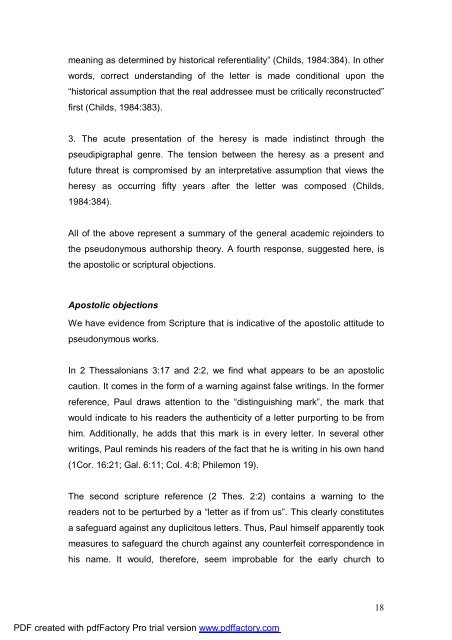A Text centred rhetorical analysis of Paul's Letter to Titus
A Text centred rhetorical analysis of Paul's Letter to Titus
A Text centred rhetorical analysis of Paul's Letter to Titus
Create successful ePaper yourself
Turn your PDF publications into a flip-book with our unique Google optimized e-Paper software.
meaning as determined by his<strong>to</strong>rical referentiality” (Childs, 1984:384). In other<br />
words, correct understanding <strong>of</strong> the letter is made conditional upon the<br />
“his<strong>to</strong>rical assumption that the real addressee must be critically reconstructed”<br />
first (Childs, 1984:383).<br />
3. The acute presentation <strong>of</strong> the heresy is made indistinct through the<br />
pseudipigraphal genre. The tension between the heresy as a present and<br />
future threat is compromised by an interpretative assumption that views the<br />
heresy as occurring fifty years after the letter was composed (Childs,<br />
1984:384).<br />
All <strong>of</strong> the above represent a summary <strong>of</strong> the general academic rejoinders <strong>to</strong><br />
the pseudonymous authorship theory. A fourth response, suggested here, is<br />
the apos<strong>to</strong>lic or scriptural objections.<br />
Apos<strong>to</strong>lic objections<br />
We have evidence from Scripture that is indicative <strong>of</strong> the apos<strong>to</strong>lic attitude <strong>to</strong><br />
pseudonymous works.<br />
In 2 Thessalonians 3:17 and 2:2, we find what appears <strong>to</strong> be an apos<strong>to</strong>lic<br />
caution. It comes in the form <strong>of</strong> a warning against false writings. In the former<br />
reference, Paul draws attention <strong>to</strong> the “distinguishing mark”, the mark that<br />
would indicate <strong>to</strong> his readers the authenticity <strong>of</strong> a letter purporting <strong>to</strong> be from<br />
him. Additionally, he adds that this mark is in every letter. In several other<br />
writings, Paul reminds his readers <strong>of</strong> the fact that he is writing in his own hand<br />
(1Cor. 16:21; Gal. 6:11; Col. 4:8; Philemon 19).<br />
The second scripture reference (2 Thes. 2:2) contains a warning <strong>to</strong> the<br />
readers not <strong>to</strong> be perturbed by a “letter as if from us”. This clearly constitutes<br />
a safeguard against any duplici<strong>to</strong>us letters. Thus, Paul himself apparently <strong>to</strong>ok<br />
measures <strong>to</strong> safeguard the church against any counterfeit correspondence in<br />
his name. It would, therefore, seem improbable for the early church <strong>to</strong><br />
PDF created with pdfFac<strong>to</strong>ry Pro trial version www.pdffac<strong>to</strong>ry.com<br />
18

















